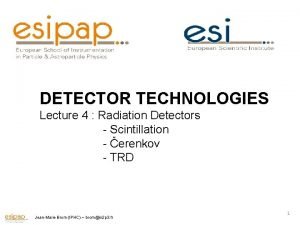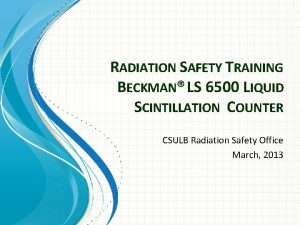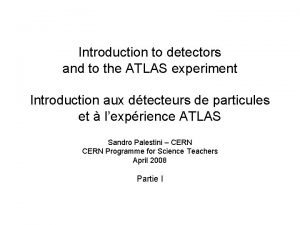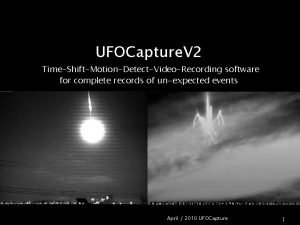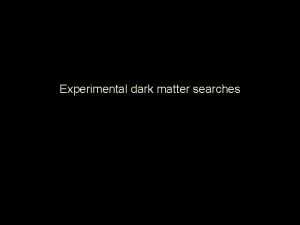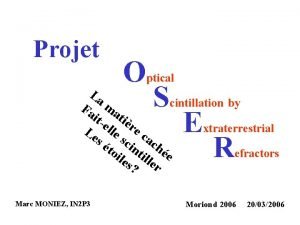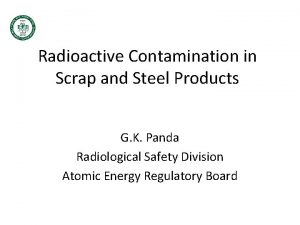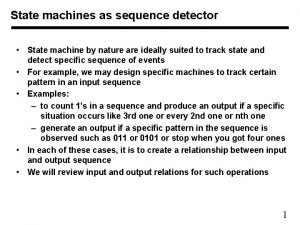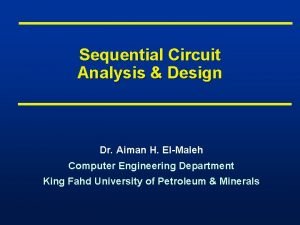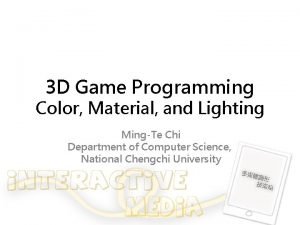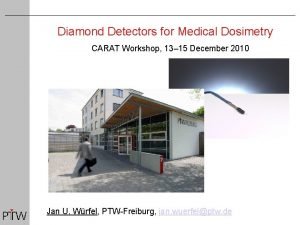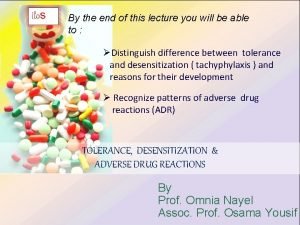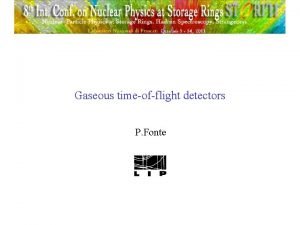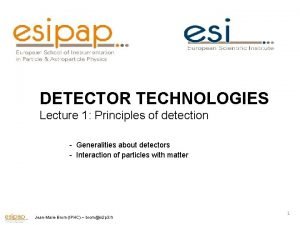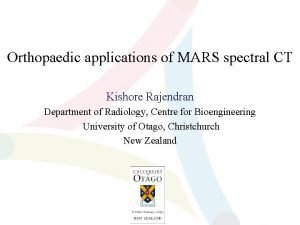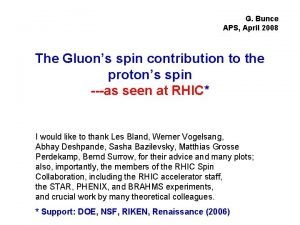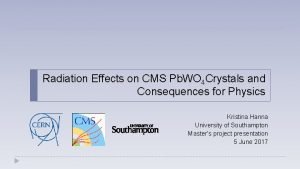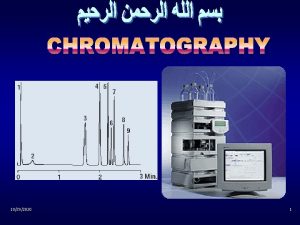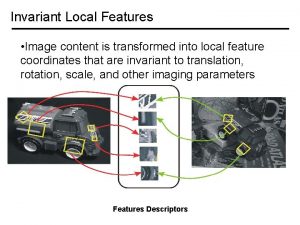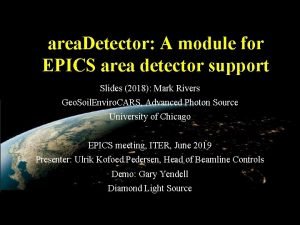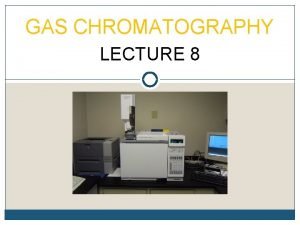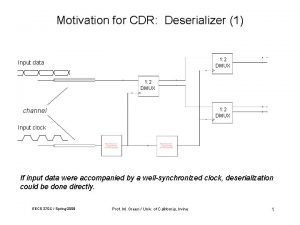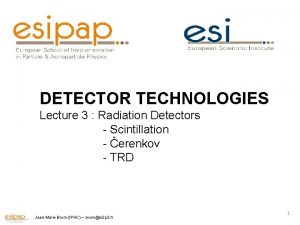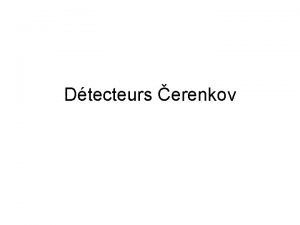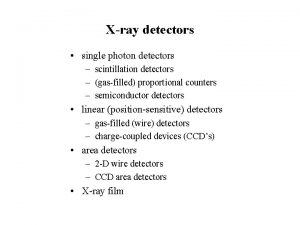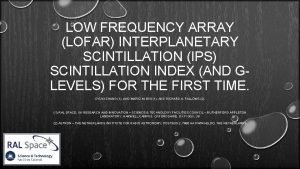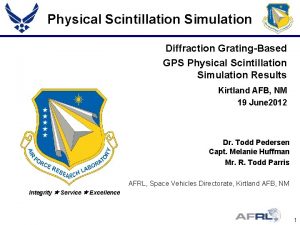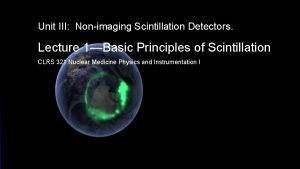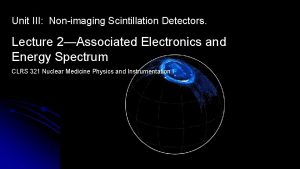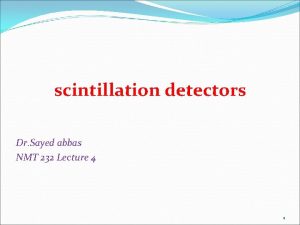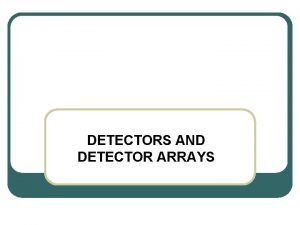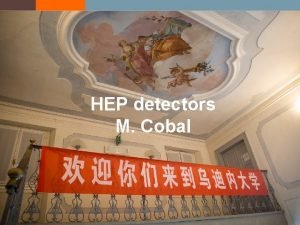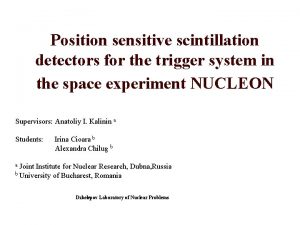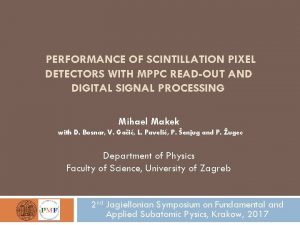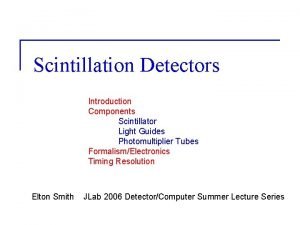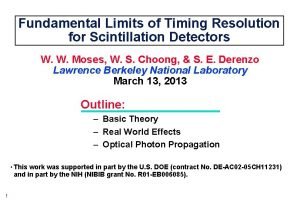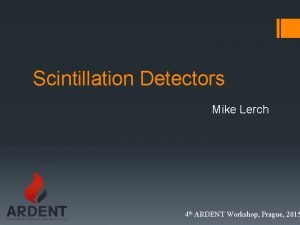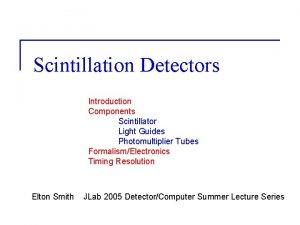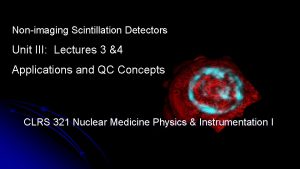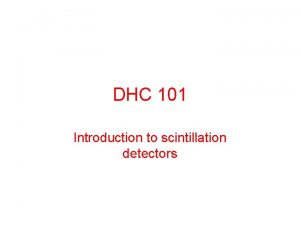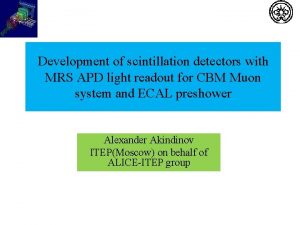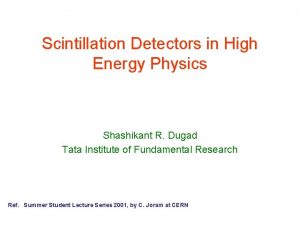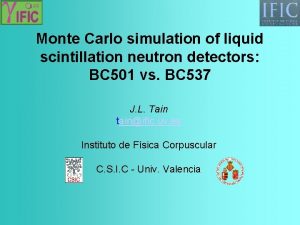DETECTOR TECHNOLOGIES Lecture 4 Radiation Detectors Scintillation erenkov







































- Slides: 39

DETECTOR TECHNOLOGIES Lecture 4 : Radiation Detectors - Scintillation - Čerenkov - TRD Jean-Marie Brom (IPHC) – brom@in 2 p 3. fr 1

Scintillation : principles Scintillator : a material which emits light (photons), when stimulated Of course, we need a light sensor to transform the light in an electric signal ≈ nsec. - µsec. Fluorescence ≈ µsec. - mins Phosphorescence Scintillator Ligth guide Jean-Marie Brom (IPHC) – brom@in 2 p 3. fr Photo detector Read out 2

Scintillation : principles For a scintillator, what is important ? - Scintillation efficiency : energy needed for 1 - emission - Light spectrum : in order to adapt the read out system to the proper wavelength - Light decay time - absorption - Transparency : the emitted should not be re-absorbed. 2 types of scintillators : Organics (liquids, plastics) Inorganics (crystals, liquids) Advantage : Fast Advantages : good efficiency Disadvantages : rather innefficients good linearity non-linear (need quenching) radiation tolerance not good for ‘s Disadvantages : relatively slow expensive (if crystals) Used mainly for trigger purpose Jean-Marie Brom (IPHC) – brom@in 2 p 3. fr Used mainly for measurements 3

Scintillation : Organic scintillators Organic Scintillators : 1. Excitation of organic molecules Yield ≈ 1 per loss of 100 e. V λ ≈100 nm (UV) 1. Absorption and re-emission λ ≈300 nm (UV) 2. Absorption and re-emission λ ≈ 400 nm (Blue) Wave shifter (adapts to the read-out) slows the process induce a non-linearity Low Z (organic = Hydrogen + Carbon) low efficiency for HE (only Compton effect) but good efficiency for neutrons Jean-Marie Brom (IPHC) – brom@in 2 p 3. fr 4

Scintillation : Organic scintillators Wavelenght shift Jean-Marie Brom (IPHC) – brom@in 2 p 3. fr 5

Scintillation : Inorganic scintillators : crystals Crystals (Na. I, Cs. I, BGO, Pb. WO 4…) Energy loss will induce electron-hole pairs creation migration to activation centers (fast) - excitation – transition - emission trapping (slow) Activator is choosen for visible emission 2 or more wavelenghts (addition of activator) Liquid noble gases (Lar, Lxe, LKr) Still 2 time constants Same wavelengths (pure gases) Precision measurements Jean-Marie Brom (IPHC) – brom@in 2 p 3. fr 6

Scintillation : Inorganic scintillators Inorganic crystals are temperature-sensitive (calorimeters have to be cooled) Jean-Marie Brom (IPHC) – brom@in 2 p 3. fr 7

Scintillation : Inorganic scintillators Jean-Marie Brom (IPHC) – brom@in 2 p 3. fr 8

Scintillation : Transport of light The readout has to be adapted to geometry and emission spectrum of the scintillator. Light guide Total reflection inside the light guide Material : PPMA (Polymethylmethacrylat) Plexiglas (C 5 O 2 H 8)n Jean-Marie Brom (IPHC) – brom@in 2 p 3. fr 9

Scintillation : Transport of light Optical fiber Improved aperture with multi-cladding Jean-Marie Brom (IPHC) – brom@in 2 p 3. fr 10

Scintillation : Transport of light Scintillating fiber : optical fiber filled with scintillator (plastic or liquid) # Decay Time, 1/e Length Characteristics/ of Photons ns m* Applications per Me. V** General purpose; 2. 7 2. 2 ~8000 optimized for diameters >250μm Improved transmission 3. 2 2. 7 ~8000 for use in long lengths Fiber Emission Color Emission Peak, nm BCF-10 blue 432 BCF-12 blue 435 BCF-20 green 492 2. 7 >3. 5 ~8000 Fast green scintillator BCF-60 green 530 7 3. 5 ~7100 3 HF formulation for radiation hardness BCF-91 A green 494 12 >3. 5 n/a Shifts blue to green BCF-92 green 492 2. 7 >3. 5 n/a Fast blue to green shifter BCF-98 n/a n/a n/a Clear waveguide Jean-Marie Brom (IPHC) – brom@in 2 p 3. fr Stack of Sci Fibers (UA 2) 11

Scintillation : Photodetector : Convert the scintillating ligth into usable electronic signal (HE Physics : usually visible and UV spectrum) = Convert UV and visible photons in electrons Requirement : High conversion efficiency QE = N photo-electrons / N photons Jean-Marie Brom (IPHC) – brom@in 2 p 3. fr 12

Scintillation : Photomultiplier Jean-Marie Brom (IPHC) – brom@in 2 p 3. fr 13

Scintillation : Photomultiplier Requirement : High conversion efficiency QE = N photo-electrons / N photons Total gain : δ = N electrons produced / N electrons incoming n = number of dynodes Jean-Marie Brom (IPHC) – brom@in 2 p 3. fr Resolution : linearity statistics And … Sensitivity to magnetic field 14

Scintillation : Photomultiplier Type Head-on type Tube Size Photocathode Area Shape Photocathode Area Size Wavelength (Short) Wavelength (Long) Wavelength (Peak) Spectral Response Curve Code Photocathode Material Window Material Dynode Structure Dynode Stages [Max. Rating] Anode to Cathode Voltage [Max. Rating] Average Anode Current Anode to Cathode Supply Voltage [Cathode] Luminous Sensitivity Min. [Cathode] Luminous Sensitivity Typ. [Cathode] Blue Sensitivity Index (CS 5 -58) Typ. [Cathode] Radiant Sensitivity Typ. [Anode] Luminous Sensitivity Min. [Anode] Luminous Sensitivity Typ. [Anode] Radiant Sensitivity Typ. [Anode] Gain Typ. [Anode] Dark Current (after 30 min. ) Max. [Time Response] Rise Time Typ. [Time Response] Transit Time Typ. Dia. 13 mm Round Dia. 10 mm 185 nm 650 nm 420 nm 400 U Bialkali UV glass Linear-focused 10 1250 V 0. 1 m. A 1000 V 40 μA/lm 110 μA/lm 10 80 m. A/W 30 A/lm 110 A/lm 8. 0 x 104 A/W 1. 0 x 106 1 n. A 15 n. A 2. 1 ns 22 ns Jean-Marie Brom (IPHC) – brom@in 2 p 3. fr 15

Scintillation : Photomultipliers evolutions Multi anode PMT Resistant to magnetic field Jean-Marie Brom (IPHC) – brom@in 2 p 3. fr 16

Scintillation : HPD Hybrid Photo Diode (HPD) highly segmented read out Good sensitivity (PMT like) Speed Less sensistive to Mag. Field Precision Jean-Marie Brom (IPHC) – brom@in 2 p 3. fr 17

Scintillation : HPD LHCb : Cerenkovs read-out with HPDS Jean-Marie Brom (IPHC) – brom@in 2 p 3. fr 18

Scintillation : HPD Cms /HCAL read-out with HPDs Jean-Marie Brom (IPHC) – brom@in 2 p 3. fr 19

Scintillation : APD Avalanche Photo Diode (APD) : an all-silicon device. - high photo conversion Q eff ≈ 0. 7 - Very high electric field 10 5 V/m(avalanche mode) - Thick - Linear mode Good tolerance with mag. Field good (? ) tolerance to radiation Jean-Marie Brom (IPHC) – brom@in 2 p 3. fr 20

Scintillation : APD CMS APDs : ≈ 141 500 Pieces for the ECAL (scintillator : PWBO 4) Active size : 5 x 5 mm 2 Jean-Marie Brom (IPHC) – brom@in 2 p 3. fr 21

Scintillation : Si. PM PPD : Pixelized Photon Detector = Si. PM : Silicon Photomultplicator = APDs in parallel with resistors - high photo conversion Q eff ≈ 0. 7 - Very high Gain (10 5) - Geiger mode - Pixelized - Not a proportional counter - Very good position counter - Adapted to fibers (small surface) Jean-Marie Brom (IPHC) – brom@in 2 p 3. fr 22

Scintillation : Si. PM Jean-Marie Brom (IPHC) – brom@in 2 p 3. fr 23

Scintillation : Si. PM Jean-Marie Brom (IPHC) – brom@in 2 p 3. fr 24

Scintillation : Photomultiplier Jean-Marie Brom (IPHC) – brom@in 2 p 3. fr 25

Čerenkov Detectors Particle travelling faster than light in a given medium emits radiation (photons) and Typical : 0. 35 µm < λ cerenkov < 0. 55 µm (usual medium : 1 < n < 2) Jean-Marie Brom (IPHC) – brom@in 2 p 3. fr 26

Čerenkov Radiation intensity (Franck-Tamm formula) : α = 1 / 137 λ = Cerenkov light θ = Cerenkov angle Medium n Θ max N photons He 1. 000035 0. 48 0. 39 Air 1. 000283 1. 36 3. 12 Freon (gas) 1. 00072 2. 17 7. 95 Isobutane 1. 00127 2. 89 14. 91 Freon (liquid) 1. 233 35. 8 1899 Water 1. 33 41. 2 2407 Plexigas 1. 5 48. 2 3084 For a charged (1) particle, = 1 Jean-Marie Brom (IPHC) – brom@in 2 p 3. fr 27

Threshold Čerenkov Threshold Crenekov detectors make a simple decision on wether the particle is above or below the Cerenkov threshold velocity. Used for differentiating heavy particles (π, K, p) Changing the gas pressure Changes the refractive index Jean-Marie Brom (IPHC) – brom@in 2 p 3. fr 28

Threshold Čerenkov Aerogel : silicate gel (99. 8% Air) Jean-Marie Brom (IPHC) – brom@in 2 p 3. fr 29

Threshold Čerenkov Jean-Marie Brom (IPHC) – brom@in 2 p 3. fr 30

RICH Čerenkov Ring Imaging Cherenkov (Ypsilantis and Seguinot -1977) Jean-Marie Brom (IPHC) – brom@in 2 p 3. fr 31

RICH Čerenkov The LHCb RICH C 4 F 10 in RICH 1 (n = 1. 0014) CF 4 in RICH 2 (n = 1. 005) Read-out : HPDs Jean-Marie Brom (IPHC) – brom@in 2 p 3. fr 32

RICH Čerenkov Jean-Marie Brom (IPHC) – brom@in 2 p 3. fr 33

Transition Radiation Detector Transition radiation is a photon emission (X) occuring when a charged particle passes through inhomogeneous media, such as a boundary between two different media with different dielectric properties Emission at an angle Very low rate Jean-Marie Brom (IPHC) – brom@in 2 p 3. fr 34

Transition Radiation Detector ALICE TRD Jean-Marie Brom (IPHC) – brom@in 2 p 3. fr 35

Transition Radiation Detector ALICE TRD Jean-Marie Brom (IPHC) – brom@in 2 p 3. fr 36

Transition Radiation Detector ATLAS TRT : Combination Tracker / TRD About 300 000 Straw tubes : position measurement by d. E/d. X radiation occurs on the wall of the tube Jean-Marie Brom (IPHC) – brom@in 2 p 3. fr 37

Transition Radiation Detector ATLAS TRT : Combination Tracker / TRD About 300 000 Straw tubes : position measurement by d. E/d. X radiation occurs on the wall of the tube Jean-Marie Brom (IPHC) – brom@in 2 p 3. fr 38

Jean-Marie Brom (IPHC) – brom@in 2 p 3. fr 39
 Hpdcms
Hpdcms Beckman ls6500 liquid scintillation counter
Beckman ls6500 liquid scintillation counter Scintillation liquide
Scintillation liquide Scintillation
Scintillation Scintillation
Scintillation Scintillation
Scintillation Scintillation
Scintillation Weighbridge radiation detector
Weighbridge radiation detector Where are feature detectors located
Where are feature detectors located Giant wave detectors murmurs universe
Giant wave detectors murmurs universe Frontier detectors for frontier physics
Frontier detectors for frontier physics Photo detectors
Photo detectors Feature detectors ap psychology
Feature detectors ap psychology Giant gravitational wave detectors hear murmurs
Giant gravitational wave detectors hear murmurs Diagnosing error in object detectors
Diagnosing error in object detectors Nuclear detectors
Nuclear detectors Rhmd: evasion-resilient hardware malware detectors
Rhmd: evasion-resilient hardware malware detectors Streaming current
Streaming current Photo detectors
Photo detectors Chromatography mobile phase and stationary phase
Chromatography mobile phase and stationary phase Feature detectors
Feature detectors Vhv voltage detectors
Vhv voltage detectors 01:640:244 lecture notes - lecture 15: plat, idah, farad
01:640:244 lecture notes - lecture 15: plat, idah, farad 011 sequence detector
011 sequence detector Sequence detector 1101
Sequence detector 1101 Color detector
Color detector Ptw diamond detector
Ptw diamond detector Retinoids
Retinoids Detector de fonte
Detector de fonte Thermal conductivity detector
Thermal conductivity detector Font detector
Font detector Ct scan detector
Ct scan detector Particle detector
Particle detector Cms detector
Cms detector Hplc detector types
Hplc detector types Harris corner detector
Harris corner detector Area detector
Area detector Fid detector principle
Fid detector principle Hogge phase detector
Hogge phase detector How to find the direct object
How to find the direct object
